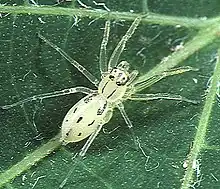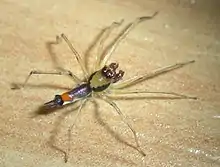Asemoneinae
Asemoneinae is a subfamily of jumping spiders (family Salticidae). It was created in 2015 by Wayne Maddison. Most species are found in Africa or Asia. The subfamily initially had five genera,[1] but Hindumanes was later transferred to the subfamily Lyssomaninae.[2]
| Asemoneinae | |
|---|---|
 | |
| Female Asemonea tanikawai | |
 | |
| Male Asemonea tenuipes | |
| Scientific classification | |
| Domain: | Eukaryota |
| Kingdom: | Animalia |
| Phylum: | Arthropoda |
| Subphylum: | Chelicerata |
| Class: | Arachnida |
| Order: | Araneae |
| Infraorder: | Araneomorphae |
| Family: | Salticidae |
| Subfamily: | Asemoneinae Maddison, 2015 |
| Genera | |
Description
Members of the subfamily Asemoneinae are translucent and long-legged relative to most other salticids. They resemble members of the subfamilies Onomastinae and Lyssomaninae sensu Madison, 2015. The posterior median eyes are unusually central for salticids, being distinctly closer to the midline than is the inner edge of the anterior lateral eyes.[1]
Taxonomy
In 2015, Wayne Maddison divided the subfamily Lyssomaninae, as circumscribed in 1980 by Wanless, into three subfamilies, Onomastinae, Asemoneinae and Lyssomaninae s.s. Maddison included five genera. Molecular data united the three sampled genera, Asemonea, Goleba and Pandisus. Two genera, Hindumanes and Macopaeus, were included based on previous classifications.[1] In 2017, Hindumanes, whose type species was originally placed in Lyssomanes, was moved to Lyssomaninae s.s., on the basis of the similarity of the male palpal bulb.[2]
References
- Maddison, Wayne P. (2015), "A phylogenetic classification of jumping spiders (Araneae: Salticidae)", Journal of Arachnology, 43 (3): 231–292, doi:10.1636/arac-43-03-231-292, S2CID 85680279
- Sudhin, P.P.; Nafin, K.S. & Sudhikumar, A.V. (2017). "Revision of Hindumanes Logunov, 2004 (Araneae: Salticidae: Lyssomaninae), with description of a new species from the Western Ghats of Kerala, India". Zootaxa. 4350 (2): 317–330. doi:10.11646/zootaxa.4350.2.7. PMID 29245556.